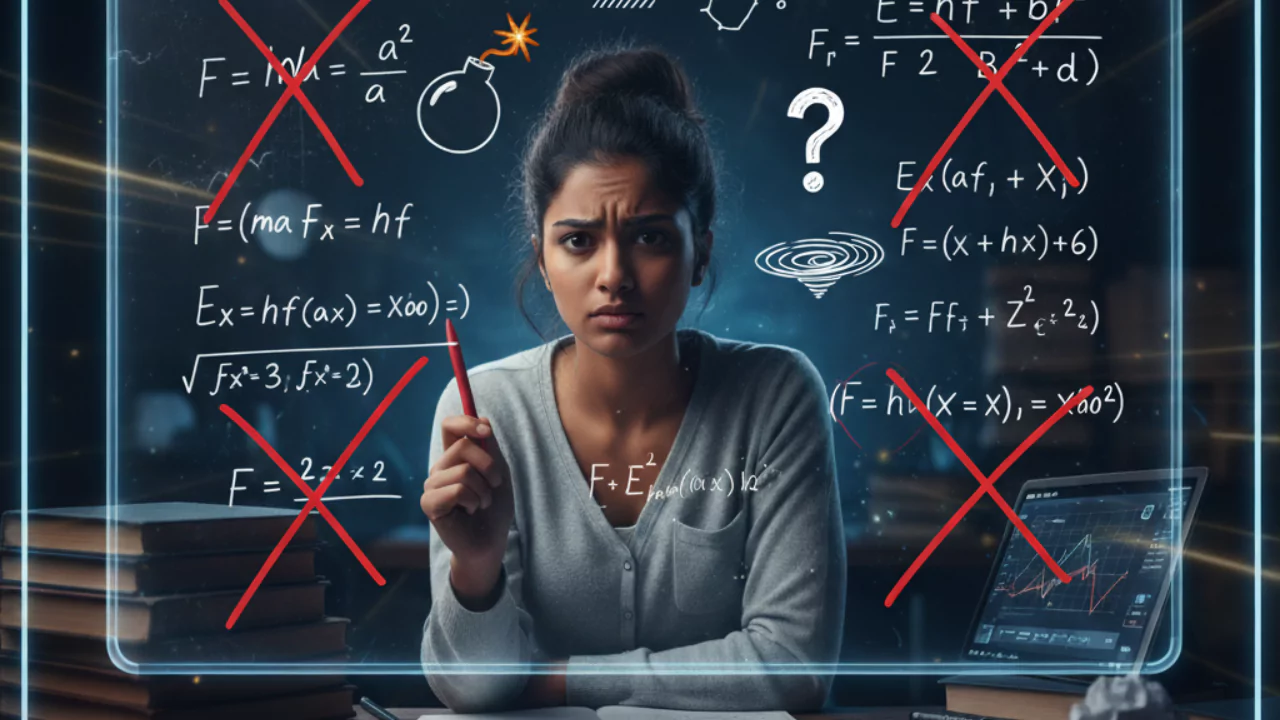Physics equations are a core part of the MCAT. But often, students lose points not because they don’t know what the formulas are—they lose marks because they misuse them. Small errors like mixing up units or forgetting constants can cost you big.
In this article, we’ll go through 10 of the most common mistakes students make when using MCAT physics equations. More importantly, we’ll give you actionable tips to avoid making these mistakes—so you can solve questions more confidently and maximize your score.
Quick Answer: What is going wrong?
Students often lose points due to:
Forgetting or converting units incorrectly.
Confusing similar equations.
Memorizing without understanding.
Ignoring important constants.
Mis‐use of kinematics formulas.
Lack of practice with real MCAT style.
Mismanaging non-calculator math.
Not knowing when an equation isn’t needed.
Mixing physics and chemistry formulas.
Poor time management.
1. Mistake #1: Forgetting Units and Conversions
What goes wrong
-
Students often plug numbers into equations without checking that units match (e.g. mixing meters with centimeters, seconds with minutes).
-
Misinterpreting what units are given or expected can lead to answers that are numerically correct but invalid in the context of the question.
-
Example: Using density in g/mL when the rest of the problem uses kg/m³, or forgetting to convert time units.
Why it matters
-
SI units (International System of Units) are fundamental in MCAT physics problems.
-
Dimensional analysis is used to check consistency of equations.
How to avoid it
-
Always write down (or mentally track) units for each variable before plugging into the equation.
-
Memorize key conversions: e.g., 1 m = 100 cm, 1 kg = 1000 g, 1 atm = 101.3 kPa, seconds vs minutes.
-
Use dimensional analysis: check that the resulting unit makes sense for what is being solved.
-
Practice problems that explicitly test unit conversion (look back at AAMC Section Banks, or practice tests).
2. Mistake #2: Confusing Similar Equations (Kinematics, Work, Energy)
What goes wrong
-
Students mix up equations that look alike, e.g., W=FdW = Fd vs W=FdcosθW = Fd \cos \theta.
-
Misapplying kinematics equations (like thinking one applies in a case where acceleration isn’t constant).
Why it matters
-
Each equation has domain conditions — e.g. constant acceleration, force vector direction, etc.
-
MCAT often tests concept of when to use which equation, not just solving plug-and-chug.
How to avoid it
-
Create a comparison sheet (side-by-side) of similar equations. Note their conditions and differences.
-
Practice selecting the correct equation given a scenario (e.g. identify whether acceleration is zero, whether angle matters).
-
Visual aids: flowcharts or decision trees (e.g. “Is acceleration constant? → yes → use kinematics set A, else kinetics / energy approach”).
3. Mistake #3: Over-Memorizing Without Understanding
What goes wrong
-
Students try to memorize every equation, variable, and sub‐case without really understanding how they’re derived or when they apply.
-
This tends to break down under pressure or when equations are slightly changed or combinations are required.
Why it matters
-
MCAT emphasizes reasoning: you may need to tweak or combine equations, or deduce relationships rather than recall verbatim.
How to avoid it
-
For each equation learn its derivation or at least rationale (why each term is there).
-
Practice altering one variable and seeing how it affects others (sensitivity).
-
Use practice questions that force you to derive or adapt equations—not only questions that simply ask you to plug‐in.
4. Mistake #4: Ignoring Constants (Planck’s, Boltzmann, etc.)
What goes wrong
-
Failing to know which constants are given by the exam vs which must be memorized.
-
Forgetting constants like Boltzmann’s constant, Planck’s constant, gravitational constant, etc.
Why it matters
-
Constants are often needed for physics formula problems, particularly in thermodynamics, quantum, statistical mechanics.
How to avoid it
-
Get a list of all constants that the AAMC provides on formula sheets (if any) and those you must remember.
-
Memorize essential constants (e.g. Planck’s constant, Boltzmann constant, gravitational constant, speed of light) with units.
-
Use flashcards specifically for constants; test yourself in the context of sample problems.
5. Mistake #5: Wrong Use of the “Big Four” Kinematics Equations
(The Big Four = v=v0+atv = v_0 + at, Δx=v0t+12at2\Delta x = v_0 t + \frac{1}{2}at^2, v2=v02+2aΔxv^2 = v_0^2 + 2a \Delta x, Δx=(vˉ)t\Delta x = (\bar v) t)
What goes wrong
-
Using them where acceleration isn’t constant.
-
Plugging in wrong variables (mixing up initial vs final velocity).
-
Substituting wrong values for a, t, v etc.
Why it matters
-
These are heavily used in MCAT physics questions involving motion and force. Misuse causes simple but fatal mistakes.
How to avoid it
-
Always identify which variables are given and which are asked.
-
Verify whether acceleration is constant (if not, these equations don’t apply).
-
Practice problems with each equation so you become fluent with variables.
6. Mistake #6: Not Practicing with Real MCAT-Style Questions
What goes wrong
-
Students do textbook problems only, but those often differ in style and format from MCAT questions.
-
Overconfidence with memorized equations but underperformance when facing MCAT wording, data presentation, or constraints.
Why it matters
-
MCAT picks tricky scenarios, constraints, time pressure. Practice with real style builds familiarity.
How to avoid it
-
Use AAMC official resources (Section Banks, Question Packs).
-
Do full practice exams under timed conditions.
-
After each practice, analyze mistakes, especially mis‐use of equations.
7. Mistake #7: Mismanaging Calculator-Free Math
What goes wrong
-
Since no calculator is allowed, students sometimes try to do heavy arithmetic or ignore shortcuts.
-
Rounding too early, writing big messy expressions, which leads to arithmetic errors or time loss.
Why it matters
-
MCAT rewards speed and correctness. Poor arithmetic slows you and introduces errors.
How to avoid it
-
Practice simplifying before calculating: factor things, cancel units, pull out powers of 10.
-
Keep more significant figures until the final step.
-
Master simple arithmetic tricks: fractions, approximations, estimation.
8. Mistake #8: Not Recognizing When an Equation Isn’t Needed
What goes wrong
-
Students sometimes try to force‐fit an equation even when conceptual reasoning suffices.
-
They waste time deriving/calculating when the question could be solved by logic or approximation.
Why it matters
-
Saves time; reduces error risk. Also conserving mental bandwidth under fatigue.
How to avoid it
-
Train to ask: “Can I answer this just by understanding concept?” before pulling out equations.
-
Practice conceptual MCAT problems (e.g., what happens to potential energy if height doubles) without calculation.
9. Mistake #9: Mixing Up Physics vs Chemistry Formulas
What goes wrong
-
Confusing equations from chemistry with physics when they overlap (e.g., energy equations, gas laws).
-
Using physics formula where chemistry understanding is required (e.g. thermodynamics, Boltzmann, ideal gas law etc.)
Why it matters
-
The MCAT integrates across disciplines; clarity about which domain an equation belongs to prevents misuse.
How to avoid it
-
Maintain separate formula sheets for physics and for chemistry during study.
-
When learning a new equation, note whether it is physics, chemistry, or cross‐disciplinary.
-
Do mixed‐subject questions that force you to choose discipline appropriately.
10. Mistake #10: Poor Time Management with Equation-Based Questions
What goes wrong
-
Spending too much time on a calculation / derivation in one question.
-
Checking, re-checking, stuck on arithmetic rather than moving on.
Why it matters
-
There are many questions and strict time limits. Slow errors or spending too long on one hurts your overall score.
How to avoid it
-
Use a skip & return strategy: mark hard/long ones, come back.
-
Practice timed sets.
-
Train to do simpler parts quickly, and recognize time sinkers.
11. How to Avoid These Mistakes: Tips & Strategies
Here are concrete strategies to help you sidestep the above mistakes:
| Strategy | What to do |
|---|---|
| Use flashcards & cheat-sheets | Make sheets for equations + units + constants. Review them daily. |
| Derivation & Concept Links | Instead of rote memorization, understand why formulas work (derivation, variables relationships). |
| Practice under test conditions | Simulate MCAT timing, no calculator, count units, etc. |
| Error analysis | After every practice test, track what mistakes you made: Was it a formula misuse? Units? Time issue? |
| Group similar equations & practice distinguishing them | Create side-by-side sheets e.g. work vs energy vs kinematics. |
| Flash, test constants often | Both what is given and what you must know. |
Final Takeaway
Mistakes with MCAT physics equations often aren’t due to lack of studying, they’re due to not studying smartly. Misused formulas, wrong units, ignoring constants, and time mismanagement are among the most frequent error sources. If you focus on understanding rather than just memorizing, practice with real MCAT-style problems, and build good habits (unit checks, constants, time awareness), you’ll avoid many common pitfalls, and your physics score will reflect that.
For more in-depth study resources, guides, and exam preparation strategies tailored to students, visit Safasolo Education, your trusted learning hub.
FAQs
Do you get a formula sheet on the MCAT?
No. The MCAT does not provide a full physics equation sheet. AAMC provides some formulas in their test manual, but you must memorize many key ones, especially those involving mechanics, kinematics, work/energy, and thermodynamics.
Which constants are given and which must I memorize?
Some constants (like gravitational acceleration ≈ 9.8 m/s²) are often assumed; others like Planck’s constant, Boltzmann constant, speed of light may or may not be given in particular sections. Memorize the major ones and their units.
How many physics equations do I need to memorize for the MCAT?
Better to focus on key categories: kinematics, forces, energy, waves, fluids, thermodynamics. Rather than trying to memorize every obscure formula, aim for depth of understanding for ~20–30 essential equations.
What are the most important physics formulas for MCAT?
Some of the highest yield include kinematics (e.g. v=v0+atv = v_0 + at), energy and work equations ( W=FdcosθW = Fd \cos θ, conservation of energy), wave equations, ideal gas law, basic electromagnetism relations (e.g. F=qvBsinθF = qvB \sin θ), pressure in fluids.
References & Credibility
-
Insights adapted from MCAT prep providers such as Blueprint Prep, their guide on common MCAT math mistakes. Blog | Blueprint Prep
-
Transformation Tutoring’s observations about units and angles in MCAT physics. transformation-
-
Forums and student discussions on common pitfalls in MCAT physics application. Student Doctor Network+1


Leave a Reply